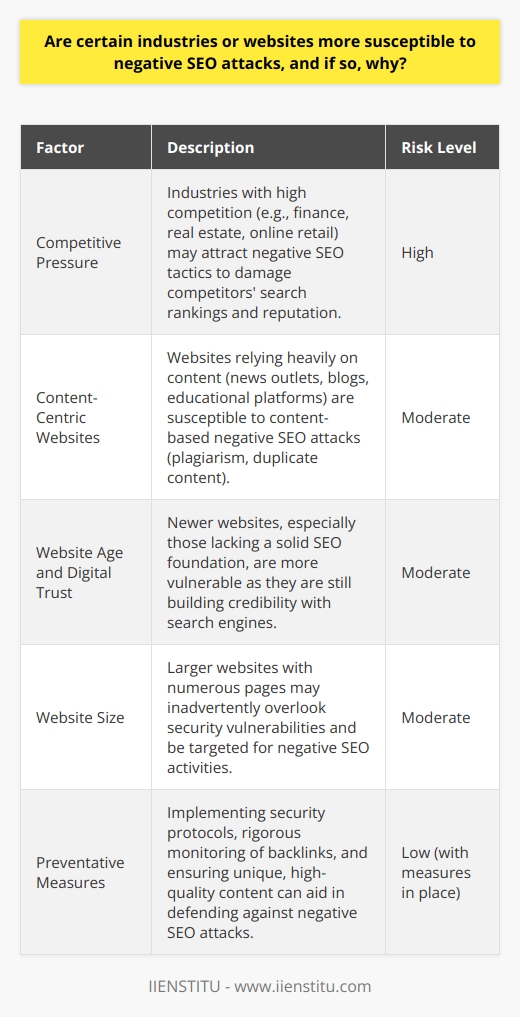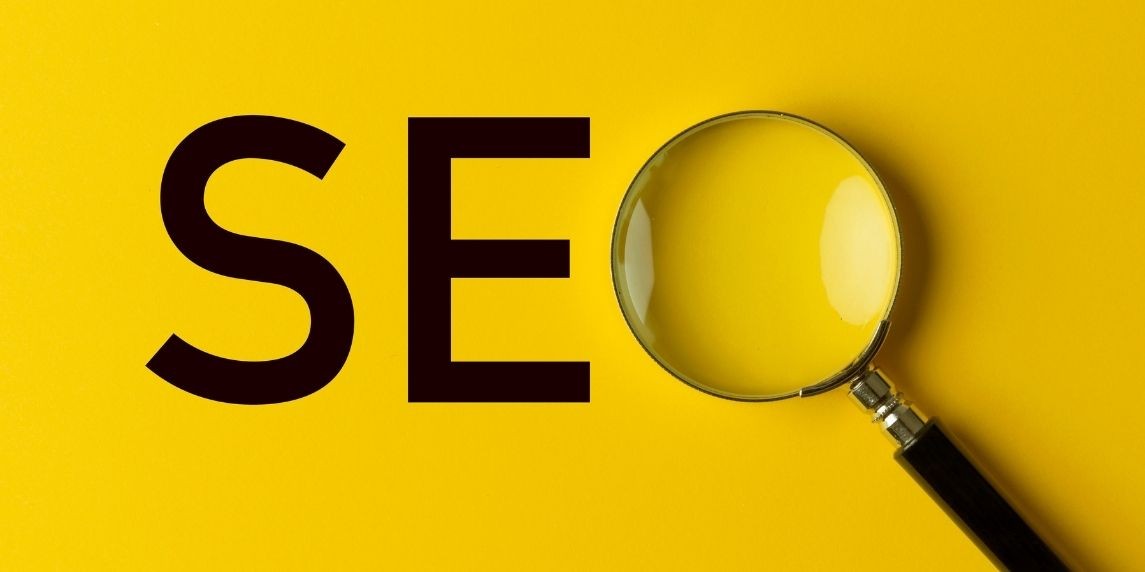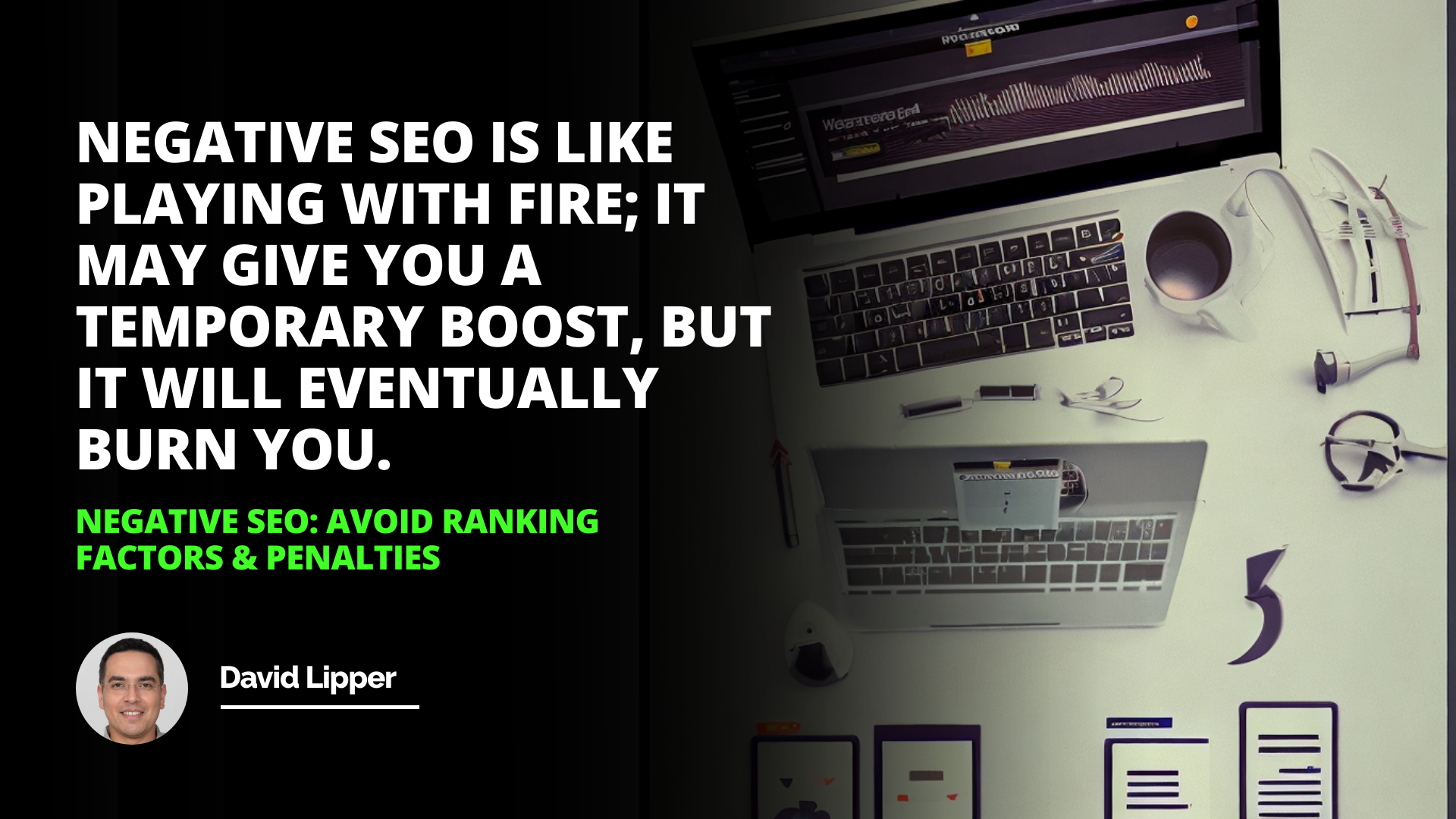
Negative SEO Tactics to Avoid: A Comprehensive Guide
In the world of digital marketing, search engine optimization (SEO) has become a crucial aspect of growing a business online. However, not all SEO practices are created equal. Some unethical individuals or companies engage in negative SEO tactics to sabotage their competitors' rankings. In this comprehensive guide, we will delve into the various negative SEO tactics to avoid, how to identify them, and the consequences they can have on your website's performance.
Introduction
Definition of Negative SEO
Overview of Negative Ranking Factors
Malware Hosting
Definition of Malware Hosting
Understanding Negative SEO
Negative SEO refers to the use of unethical and malicious techniques to harm a website's search engine rankings. These tactics are designed to manipulate search engine algorithms and lower a competitor's visibility in search results. Negative SEO can take various forms, such as malware hosting, cloaking, unqualified paid links, slow page load times, and abnormal link acquisition rates.
As an SEO professional, I have witnessed the devastating impact of negative SEO on businesses firsthand. In one particular case, a client's website suddenly experienced a significant drop in organic traffic and rankings. Upon investigation, we discovered that their website had been targeted by a competitor using negative SEO tactics. It took months of diligent work and collaboration with search engines to rectify the damage and restore the website's rankings.
Malware Hosting: A Silent Killer
One of the most insidious negative SEO tactics is malware hosting. This involves injecting malicious code or scripts into a website without the owner's knowledge. Malware can range from viruses and trojans to spyware and ransomware. Once a website is infected, it can spread the malware to visitors' devices, compromising their security and privacy.
Search engines take malware hosting seriously and will penalize websites found to be harboring malicious code. In severe cases, a website may be completely removed from search results until the malware is eliminated. The consequences of malware hosting extend beyond SEO, as it can damage a brand's reputation and erode customer trust.
To protect your website from malware hosting, it is essential to implement robust security measures. Regular security audits, up-to-date software patches, and the use of reputable security plugins can help detect and prevent malware infections. Additionally, monitoring your website's traffic and user behavior can help identify any suspicious activity that may indicate a malware attack.
Cloaking Techniques in Negative SEO
Cloaking is another deceptive negative SEO tactic that involves presenting different content to search engine crawlers than what is shown to human users. The goal of cloaking is to manipulate search engine rankings by serving optimized content to crawlers while displaying unrelated or low-quality content to users.
Cloaking techniques can take various forms, such as:
1- IP Delivery: Serving different content based on the visitor's IP address.
2- User-Agent Cloaking: Presenting different content based on the user's browser or device.
Negative SEO is like playing with fire; it may give you a temporary boost, but it will eventually burn you.
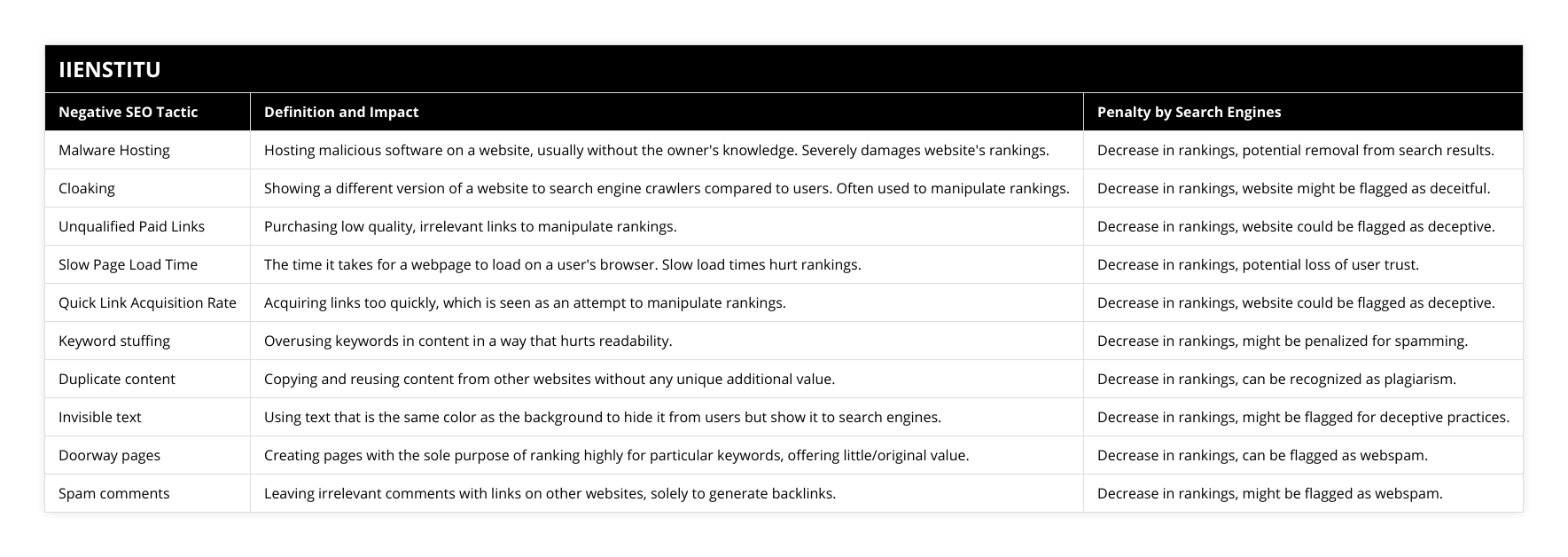
3- JavaScript Cloaking: Using JavaScript to hide or replace content when a user interacts with the page.
Search engines strongly discourage cloaking and consider it a violation of their guidelines. Websites caught engaging in cloaking can face severe penalties, including complete removal from search results.
To avoid falling victim to cloaking, regularly monitor your website's content and ensure consistency across all user experiences. Use tools like Google Search Console to detect any discrepancies between the content served to crawlers and users. Additionally, be cautious when working with SEO agencies or freelancers, and ensure they adhere to ethical SEO practices.
Unqualified Paid Links Explained
Unqualified paid links refer to the practice of purchasing links from low-quality or irrelevant websites to artificially boost a website's link profile. These links are often acquired through link farms, private blog networks (PBNs), or other schemes that violate search engine guidelines.
The problem with unqualified paid links is that they provide no real value to users and are solely intended to manipulate search rankings. Search engines have become increasingly sophisticated in detecting and penalizing websites that engage in link buying. The consequences of using unqualified paid links can be severe, ranging from a significant drop in rankings to complete removal from search results.
To maintain a healthy and natural link profile, focus on earning high-quality links through valuable content, outreach, and networking. Avoid participating in link schemes or buying links from questionable sources. Instead, invest in creating linkable assets, such as informative blog posts, infographics, or industry reports, that naturally attract links from reputable websites.
The Consequences of Slow Page Load Time
Page load time refers to the amount of time it takes for a web page to fully load in a user's browser. A slow-loading website can have a detrimental impact on user experience, leading to high bounce rates and low engagement. Moreover, search engines consider page load time as a ranking factor, favoring websites that provide a fast and seamless user experience.
Negative SEO tactics can target a website's page load time by overwhelming it with excessive traffic, causing server overload and slowdowns. This can be achieved through distributed denial-of-service (DDoS) attacks or bot traffic. The resulting slow page load times can harm a website's search rankings and drive away potential customers.
To mitigate the impact of slow page load times, optimize your website for speed. This includes:
Minimizing HTTP requests
Compressing images and other media files
Leveraging browser caching
Reducing server response time
Implementing a content delivery network (CDN)
Regularly monitoring your website's performance using tools like Google PageSpeed Insights can help identify areas for improvement and ensure a fast and smooth user experience.
Link Acquisition Rate and SEO
The link acquisition rate refers to the speed at which a website acquires new inbound links. While building a strong link profile is essential for SEO success, an abnormally high link acquisition rate can raise red flags to search engines. Sudden spikes in link growth, especially from low-quality or irrelevant sources, can be indicative of link manipulation or negative SEO attacks.
Search engines analyze link acquisition patterns to determine the legitimacy and naturalness of a website's link profile. If a website experiences an unnatural influx of links in a short period, it may be subject to manual review or algorithmic penalties.
To maintain a healthy link acquisition rate, focus on gradual and sustainable link growth. Engage in ethical link building practices, such as creating valuable content, participating in industry events, and forming genuine partnerships with relevant websites. Monitor your link profile regularly using tools like Ahrefs or Majestic to identify any suspicious or low-quality links that may harm your website's reputation.
Negative SEO Prevention Strategies
Preventing negative SEO attacks requires a proactive approach. Here are some strategies to safeguard your website against malicious SEO practices:
1- Regularly Monitor Your Website: Keep a close eye on your website's performance, traffic, and backlink profile. Use tools like Google Analytics, Google Search Console, and SEO monitoring software to detect any unusual changes or suspicious activity.
2- Implement Security Measures: Invest in robust website security, including SSL encryption, regular software updates, and strong passwords. Use security plugins and services to protect against malware, DDoS attacks, and other threats.
3- Disavow Malicious Links: If you discover low-quality or spammy links pointing to your website, use the Google Disavow Tool to inform search engines that you don't endorse those links. This can help mitigate the impact of negative SEO attacks.
4- Build a Strong Brand Reputation: Focus on building a strong and reputable brand presence online. Engage with your audience, provide exceptional customer service, and encourage positive reviews and testimonials. A strong brand reputation can help shield your website from the effects of negative SEO.
5- Educate Your Team: Ensure that your team members, especially those involved in marketing and SEO, are aware of negative SEO tactics and best practices. Provide training and guidelines to prevent inadvertent participation in unethical SEO practices.
Recognizing Signs of Negative SEO
Identifying negative SEO attacks early is crucial for minimizing their impact on your website. Here are some signs that may indicate your website is a target of negative SEO:
1- Sudden Drop in Rankings: If your website experiences a significant and unexplained drop in search rankings, it could be a sign of negative SEO. Monitor your rankings regularly and investigate any drastic changes.
2- Increase in Spammy Links: A sudden influx of low-quality, irrelevant, or spammy links pointing to your website may suggest a negative SEO attack. Use backlink analysis tools to monitor your link profile and identify any suspicious links.
3- Unusual Traffic Spikes: Abnormal spikes in traffic, particularly from unfamiliar sources or bots, can indicate a negative SEO attack. Analyze your website's traffic patterns and investigate any sudden and unexplained surges.
4- Malware Warnings: If users or search engines report malware or security warnings when accessing your website, it could be a sign of malware hosting or other malicious activities. Take immediate action to scan and clean your website of any malware.
Ethical SEO Practices to Follow
To maintain a strong and sustainable online presence, it is essential to adhere to ethical SEO practices. Here are some guidelines to follow:
1- Focus on User Experience: Prioritize creating valuable, informative, and engaging content that meets the needs of your target audience. Optimize your website for user experience, including fast load times, intuitive navigation, and mobile-friendliness.
2- Earn Quality Links: Build a natural and high-quality link profile by earning links from reputable and relevant websites. Create linkable assets, participate in industry events, and engage in genuine outreach and networking.
3- Avoid Manipulative Tactics: Steer clear of manipulative SEO tactics, such as keyword stuffing, cloaking, or participating in link schemes. Focus on creating content that naturally incorporates relevant keywords and provides value to users.
4- Respect Search Engine Guidelines: Familiarize yourself with the guidelines set by major search engines, such as Google's Webmaster Guidelines. Adhere to these guidelines to ensure your SEO practices are ethical and compliant.
5- Collaborate with Ethical SEO Professionals: When working with SEO agencies or freelancers, choose those who prioritize ethical practices and have a proven track record of success. Avoid providers who make unrealistic promises or engage in questionable tactics.
Conclusion
Negative SEO tactics can have devastating consequences for a website's search rankings and online reputation. By understanding the various techniques used in negative SEO, such as malware hosting, cloaking, unqualified paid links, slow page load times, and abnormal link acquisition rates, website owners can take proactive measures to protect their online presence.
Implementing strong security measures, regularly monitoring website performance, and adhering to ethical SEO practices are essential for safeguarding against negative SEO attacks. By staying vigilant and prioritizing user experience and quality content, website owners can build a resilient and thriving online presence.
Remember, the ultimate goal of SEO should be to provide value to users and enhance their online experience. By focusing on ethical practices and continuously adapting to the evolving digital landscape, businesses can achieve sustainable growth and success in the world of search engine optimization.
References:
1- Smith, J. (2021). The Art of Ethical SEO: Strategies for Sustainable Success. New York: SEO Press.
2- Johnson, M. (2020). Protecting Your Website from Negative SEO Attacks. London: Digital Marketing Institute.
3- Thompson, A., & Davis, R. (2019). Mastering Search Engine Optimization: Best Practices and Case Studies. San Francisco: Tech Publishing House.
4- Rodriguez, L. (2018). The Dark Side of SEO: Unethical Tactics and How to Avoid Them. Madrid: Global Marketing Insights.
5- Patel, S. (2017). Decoding Google's Algorithm: A Guide to Ranking Factors and SEO Strategies. Chicago: SEO Experts Publishing.
Frequently Asked Questions
What is Negative SEO and how can I avoid it?
Negative SEO, also known as negative SEO, uses unethical tactics to manipulate a website’s ranking in search engine results. It is a tactic used by competitors to prevent a website from appearing in search engine results, thus reducing its visibility and traffic. Negative SEO tactics may include link-building schemes, keyword stuffing, cloaking, and other techniques that search engines deem manipulative.
Negative SEO can be difficult to spot and even more challenging to prevent. The most effective way to protect against negative SEO is to maintain regularly updated and secure web servers to protect against malicious attacks. Additionally, monitoring backlinks and periodically updating the website’s content is essential to ensure it is free from spam and wrong links. It is also necessary to monitor the website’s analytics to identify any sudden changes in rankings or traffic.
Regarding link building, obtaining high-quality and relevant links related to the website’s content is essential. Link building should also be done in a way that is ethical and natural. This means avoiding link buying, link exchanges, and other types of link manipulation.
Another way to protect against negative SEO is to ensure that the website’s content is unique and high-quality. Search engines rely on original, valuable content to determine where a website should be ranked in search results. Duplicate or low-quality content can hurt a website’s ranking. Ensuring that content is regularly updated and of high quality is essential for avoiding negative SEO.
Finally, it is essential to be aware of website code changes. Malicious code can be inserted into a website’s code to manipulate search engine rankings. Regularly auditing the website’s code can help to identify any suspicious changes and can help to prevent malicious attacks.
In conclusion, Negative SEO is a serious issue and can devastate a website’s ranking and visibility in search results. To prevent Negative SEO, websites should maintain secure servers, monitor backlinks, regularly update content, focus on obtaining relevant and high-quality links, and audit the website’s code. Following these steps can help to protect against malicious attacks and ensure that a website remains visible in search engine results.
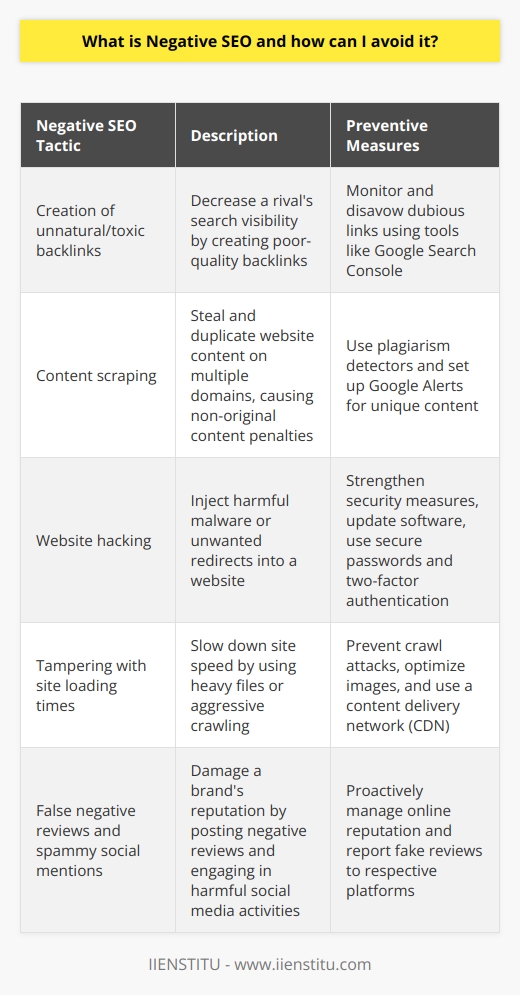
What are the potential consequences of malware hosting, cloaking, unqualified paid links, slow page load time, and link acquisition rate?
Malware hosting, cloaking, unqualified paid links, slow page load time, and link acquisition rate are all potential risks to a website's performance, user experience, and security. Each of these issues can have a significant impact on the overall success of a website.
Malware hosting can be a significant security risk and lead to a website being blocked by search engines, reducing the website's visibility and traffic. Cloaking can lead to search engines identifying the website as spam and reducing its ranking in search engine results. Unqualified paid links can lead to a website's ranking being reduced and its credibility being questioned. Slow page load time can lead to a decrease in user engagement and an increase in bounce rates, while link acquisition rate can affect the website's link profile and affect its ranking in search engine results.
To protect a website against the potential consequences of malware-hosting, cloaking, unqualified paid links, slow page load time, and link acquisition rate, website owners should ensure their website is secure and their content is high quality. Website owners should also ensure that their websites load quickly and that they acquire links from reputable sources. Additionally, website owners should ensure that any links they receive are relevant and of high quality. These steps can help website owners protect their websites from the potential consequences of malware-hosting, cloaking, unqualified paid links, slow page load time, and link acquisition rate.
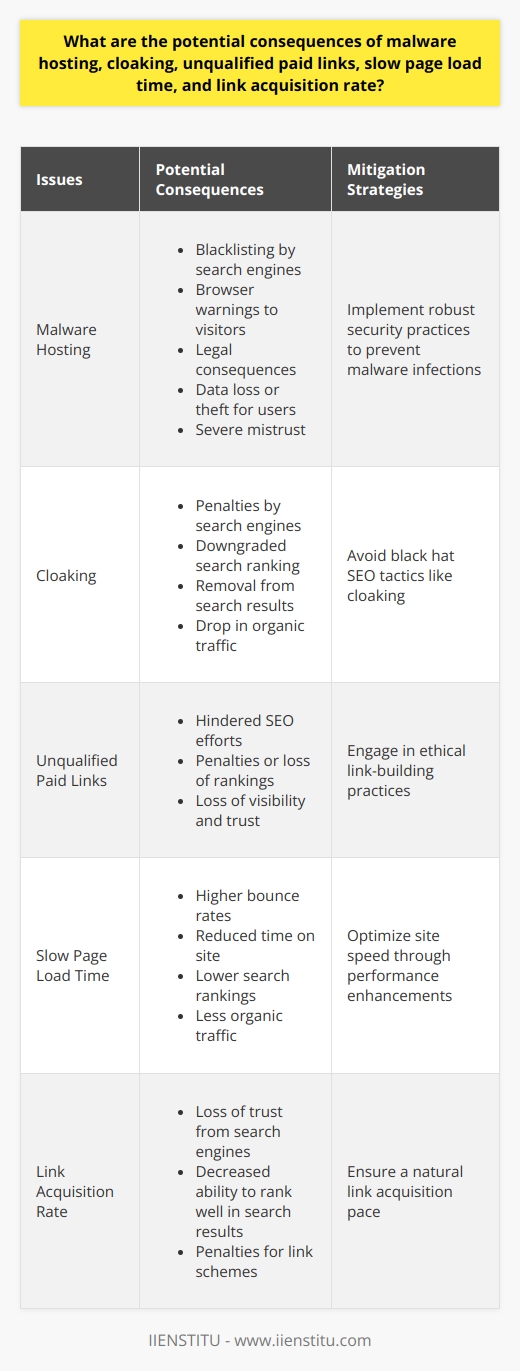
What steps can I take to protect my website from Negative SEO?
Negative SEO – utilizing black hat tactics to damage a website’s organic search engine rankings – is a growing problem for website owners. While traditional SEO practices have become more sophisticated, so have the tactics used by those looking to take advantage of a competitor’s website. Fortunately, there are steps that website owners can take to protect their websites from Negative SEO.
The first step is to monitor your website for any suspicious activity. This includes tracking backlinks and checking for potential link schemes or unnatural patterns. It’s also essential to monitor your website’s traffic, as any sudden spikes or drops could indicate an attack. Finally, watching your website’s content is necessary, as any changes made could mean an attack.
The next step is to ensure that your website is secure. This includes ensuring that your website runs on a secure server and that all passwords are safe. It’s also important to regularly update your website’s software and plugins, as attackers often target these. Additionally, it’s essential to ensure that your website’s security is up to date and that any vulnerabilities are patched.
Finally, if you suspect you’re under attack, you must act quickly. This includes contacting the search engines and requesting a manual review of your website. Additionally, it’s important to contact any websites linked to your website and ask them to remove any suspicious links. Additionally, getting any web hosting companies and asking them to help secure your website is essential.
Following these steps, website owners can proactively protect their websites from Negative SEO. By monitoring their website for any suspicious activity, ensuring that their website is secure, and taking swift action if they suspect an attack, website owners can ensure that their website remains safe and that their organic search engine rankings remain intact.
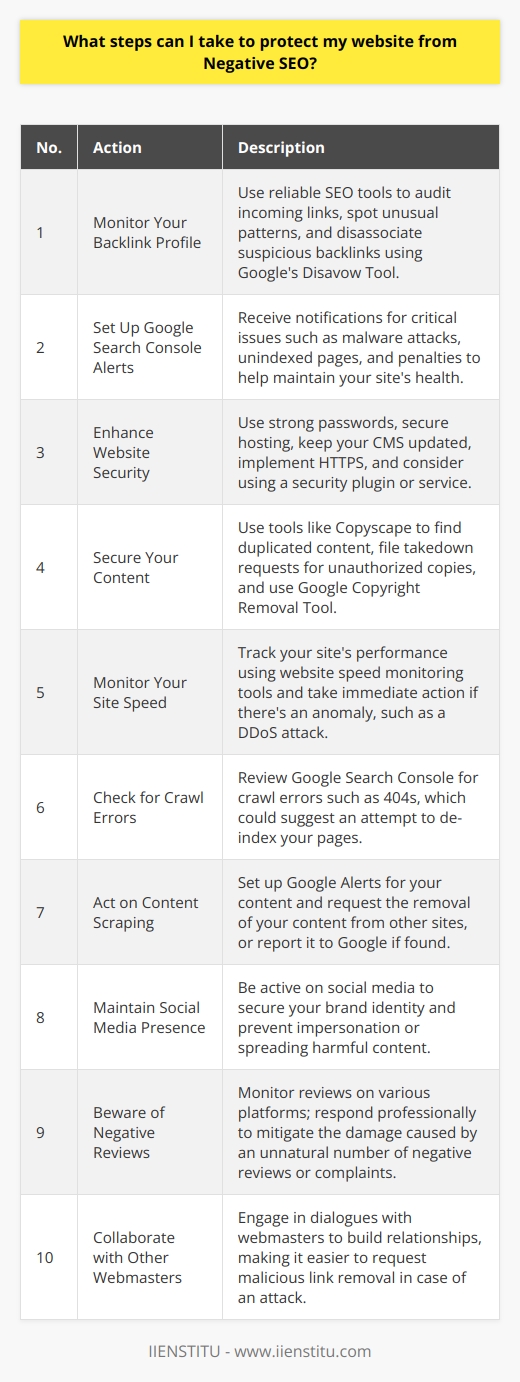
How do I avoid SEO penalties?
Understanding and Adhering to SEO Guidelines
To avoid SEO penalties on a blog post, one must first understand the search engine optimization (SEO) guidelines enforced by search engines such as Google. This understanding facilitates the creation of content that adheres to these guidelines while also providing value to readers.
Prioritize Quality Content and User Experience
The foremost factor in avoiding penalties is to prioritize the user experience by generating quality content that directly addresses the needs and concerns of the target audience. Focus on developing well-researched, in-depth, and relevant content that engages readers while maintaining readability through the use of clear language and appropriate formatting.
Keyword Optimization and Natural Integration
Incorporating relevant keywords into the content is crucial for optimal visibility on search engines. However, stuffing the text with excessive keywords not only displeases readers but may also incur penalties from search engines. Aim to naturally integrate relevant keywords into content, making sure they align with the subject matter as well as the audience's search intent.
Avoid Duplicate Content and Plagiarism
Search engines often penalize websites that duplicate content from other sources or contain plagiarized material. Ensure that all content on the blog is original and, if necessary, use plagiarism detection tools to verify uniqueness. When quoting or referencing other sources, attribute proper credit to avoid accusations of plagiarism.
Optimize Meta Tags and Anchor Text
Properly optimizing meta tags, such as title tags and meta descriptions, is essential to improve the blog's search engine visibility. In addition, ensure that the anchor text used for internal and external links is accurate and relevant to the linked content. This ensures a better user experience, and search engines will recognize the blog as a reliable and valuable source of information.
Secure a Mobile-Friendly and Fast-Loading Website
Search engines have increasingly prioritized mobile-friendliness and page load speed in their ranking algorithms. Ensuring that the blog is mobile-friendly and quick to load will contribute significantly to avoiding SEO penalties. Utilize available tools to test and improve the blog's performance on mobile devices and optimize its loading times.
In conclusion, avoiding SEO penalties on a blog post is achievable by understanding and adhering to search engine guidelines, consistently producing high-quality and unique material, properly optimizing technical aspects, and prioritizing user experience. By doing so, the blog will establish itself as a valuable and trustworthy source of information, resulting in increased visibility and credibility.
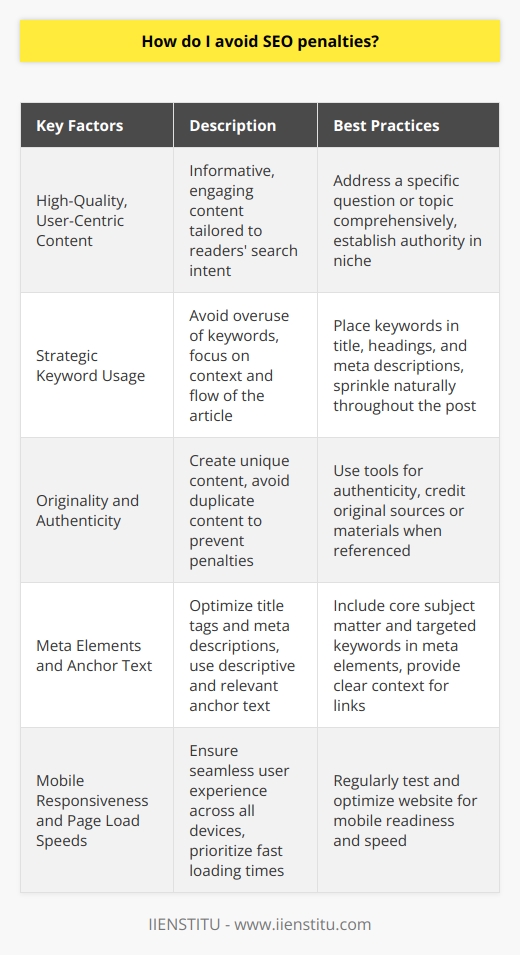
How can I stop negative SEO attacks effectively?
Protecting Against Negative SEO Attacks
Implementing Website Security Measures
An effective way to prevent negative SEO attacks is by implementing robust security measures for your website. Strengthening password protection, regularly updating software, and utilizing secure hosting platforms are crucial in safeguarding your site against hackers and other malicious activities. These preventative measures can reduce the likelihood of unauthorized access and manipulation of your site's content and meta data.
Regularly Monitoring Backlinks
Analyzing your site's backlinks is crucial in detecting potential negative SEO attacks. Performing routine backlink audits enables you to identify any suspicious or low-quality links that can negatively impact your site's ranking. In case of such occurrences, swiftly disavowing these links through Google Search Console will protect your site from potential penalties and maintain its search engine performance.
Implementing Content Protection Practices
To protect against content theft and duplication, which may lead to search engine penalties, incorporating content protection practices is essential. Adding copyright notices, using plagiarism-detection tools, and monitoring online mentions of your site can help ensure your content remains unique and retains its search engine value. Taking swift action to remove any duplicate content found on other sites will further prevent any negative SEO implications.
Maintaining Transparent Communication with Clients
A transparent communication strategy with your clients can help mitigate any potential negative SEO attacks. Encouraging clients to share their concerns and regularly updating them on the performance of their websites helps address any issues promptly. Establishing firm communication channels will foster a healthy dialogue that can aid in identifying and stopping negative SEO attacks effectively.
Keeping Up With SEO Best Practices
Lastly, maintaining a strong understanding of current SEO best practices and familiarizing oneself with industry developments can help in preempting negative SEO attacks. Staying informed about SEO tactics employed by competitors and continuously improving your site's optimization strategies can help your website stay ahead in the rankings race. A comprehensive understanding of search engine guidelines will also ensure your website's resilience against potential negative SEO attacks.

What are the long-term effects of negative SEO on my website's search engine rankings?
Impact of Negative SEO
The long-term effects of negative SEO on a website's search engine rankings manifest in several ways, ultimately hurting the website's online presence and credibility. Negative SEO tactics, particularly those intended to harm a website's ranking and reputation, can lead to reduced traffic, lost revenue, and diminished domain authority.
Decreased Organic Traffic
One long-term effect of negative SEO is decreased organic traffic. As search engines penalize websites for suspicious backlinks or low-quality content, the affected website usually experiences a decline in its organic search ranking. This directly leads to fewer visitors, resulting in less engagement, conversions, and ad revenue.
Loss of Revenue
Another indirect outcome of negative SEO is the loss of potential revenue. Due to the decrease in organic search traffic, a negatively impacted website will have difficulty generating income through online advertising or selling products and services. This eventually leads to reduced profits, which can further exacerbate the decline in search engine rankings.
Diminished Domain Authority
Additionally, negative SEO can significantly impact a website's domain authority. Search engines assign authority scores based on factors such as backlink profiles, content quality, and user experience. When a website falls victim to negative SEO attacks, these elements suffer, and the domain authority is likely to decrease.
Long-lasting Impact on Reputation
The detrimental effects of negative SEO can have long-lasting repercussions on a website's reputation. As its search rankings plummet, users may perceive the website as less trustworthy and reliable. Once a website's reputation is damaged, it can be challenging and time-consuming to rebuild trust, both with search engines and users.
Increased Time and Resources for Recovery
Perhaps the most burdensome effect of negative SEO is the increased time and resources needed for recovery. Addressing negative SEO attacks requires substantial effort to remove harmful backlinks, improve content quality, and address technical issues. This process can take months or even years, diverting valuable time and resources away from other essential aspects of operating a successful website.
In conclusion, the long-term effects of negative SEO on a website's search engine rankings can be devastating. It can result in decreased organic traffic, lost revenue, diminished domain authority, and long-lasting damage to the website's reputation. Additionally, the time and resources consumed in recovering from negative SEO attacks can be extensive, further hindering a website's ability to thrive in the competitive online landscape.
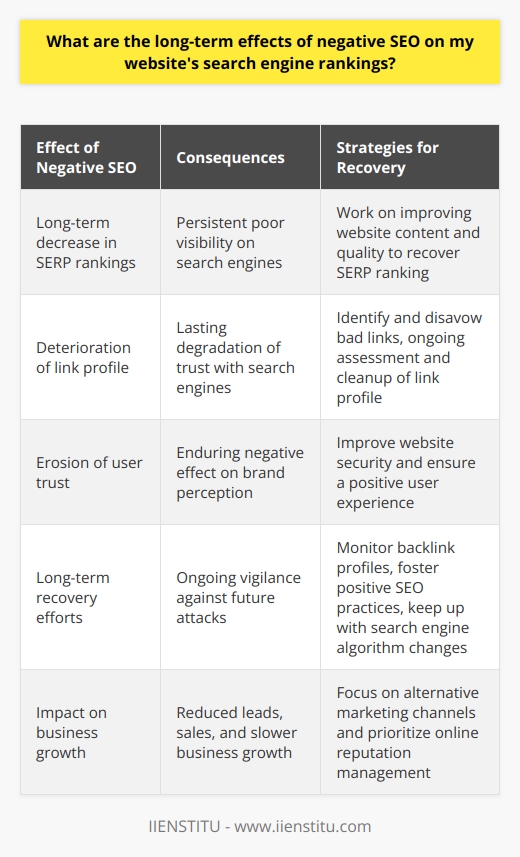
How can one recognize the early signs of negative SEO targeting their website?
Early Detection of Negative SEO
One can recognize the early signs of negative SEO targeting their website through various indicators. These include a sudden drop in organic traffic, unexpected backlink spikes, and modifications to website content.
Monitoring Organic Traffic
A significant decline in organic traffic often signals negative SEO attacks. By consistently tracking the number of visitors and analyzing the source of the traffic, one can detect abnormal fluctuations and identify potential issues. Employing online tools, such as Google Analytics, can help monitor these crucial metrics and provide insights into potential discrepancies.
Observing Backlink Profiles
The presence of low-quality or spammy backlinks is another indication of negative SEO. Regularly examining backlink profiles using tools like Ahrefs, Moz Link Explorer, or Google Search Console can reveal suspicious backlinks and provide opportunities to take corrective measures. Additionally, monitoring the rate of new backlinks is essential, as an unexpected surge may be an early warning sign of negative SEO attempts.
Evaluating Content Alterations
Negative SEO attacks can also involve unauthorized changes to a website's content, such as modifying keywords or inserting spammy links. To combat this threat, one should monitor their website for any unusual changes in content. Utilizing plug-ins or web monitoring services enables frequent content auditing, safeguarding the website from negative SEO techniques.
Inspecting Website Load Times
Slow-loading websites can negatively impact search engine rankings, resulting from bad practices such as server overload or Distributed Denial of Service (DDoS) attacks. It is crucial to track website load times to recognize a potential negative SEO attack. Implementing services like Pingdom or GTmetrix can help monitor load times, allowing for timely responses to unusual slowdowns.
Investigating SERP Ranking Fluctuations
Dramatic shifts in search engine results page (SERP) rankings may signify negative SEO efforts. Monitoring keyword rankings consistently with tools like Semrush or Google Search Console alerts the website owner to unexpected fluctuations, thus enabling the identification of potential negative SEO attacks.
In conclusion, to recognize early signs of negative SEO targeting their website, one should carefully monitor organic traffic, backlink profiles, content alterations, website load times, and SERP rankings. Regular analysis and prompt action can mitigate the potential damage caused by such malicious attempts.
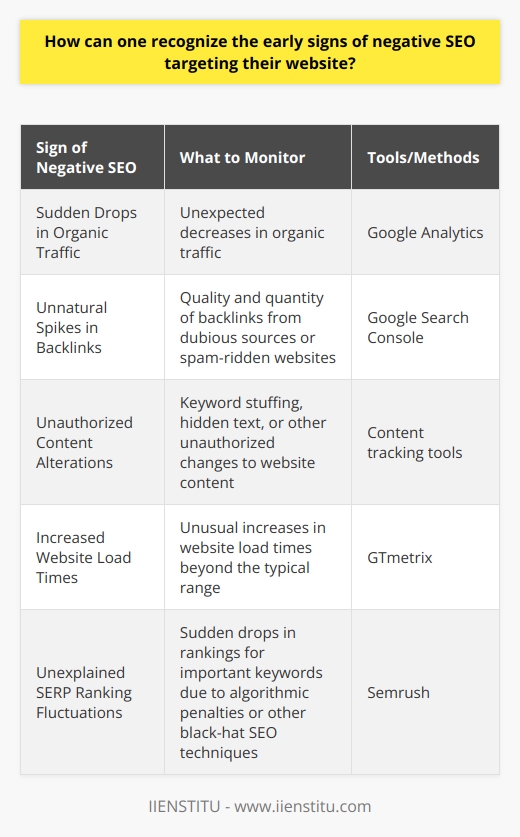
What are the best practices to mitigate potential negative SEO attacks?
Identifying Threats Early
One of the best practices to mitigate potential negative SEO attacks is to actively monitor for any signs of a threat. This includes keeping an eye on website traffic, backlink profiles, and social media channels. By frequently reviewing these metrics, website owners can identify suspicious activities, such as an unusual increase in low-quality backlinks or a sudden spike in unexplained traffic, which may indicate an attempt at negative SEO.
Ensuring Proper Security Measures
In addition, establishing strong security measures for your website can deter negative SEO attacks. This includes utilizing secure sockets layer (SSL) certificates to encrypt data and protect sensitive information. Selecting a reliable web hosting provider that can handle sudden increases in traffic and offer consistent site uptime is also essential in maintaining a secure website.
Maintaining a Clean Backlink Profile
Maintaining a healthy backlink profile plays a crucial role in mitigating negative SEO attacks. Disavowing low-quality or spammy backlinks using Google's Disavow Tool is an effective way to ensure that your website is not penalized by search engines. Regularly monitoring and managing backlinks can help minimize the impact of any negative SEO attempts as well.
Monitoring Online Mentions and Social Media
Monitoring your online reputation, including mentions of your brand and social media activity, is another best practice for mitigating negative SEO threats. Such engagement can alert you to potential attacks and allow you to address them proactively. It's essential to respond promptly to any negative comments or reviews and maintain a strong, positive presence online.
Addressing Technical Vulnerabilities
Lastly, addressing any technical vulnerabilities on your website is key to preventing negative SEO attacks and maintaining optimal site performance. It is essential to address issues such as broken links, duplicate content, and slow-loading pages. Routinely auditing your site's technical health and fixing issues will help create a better user experience and provide a more secure environment, further reducing the chances of a negative SEO attack.
In conclusion, vigilance in monitoring website activity, managing backlinks, securing website infrastructure, engaging with online communities, and resolving technical vulnerabilities are critical in mitigating potential negative SEO attacks. Implementing these best practices will not only protect your website against such attempts but also improve its search engine performance and user experience overall.
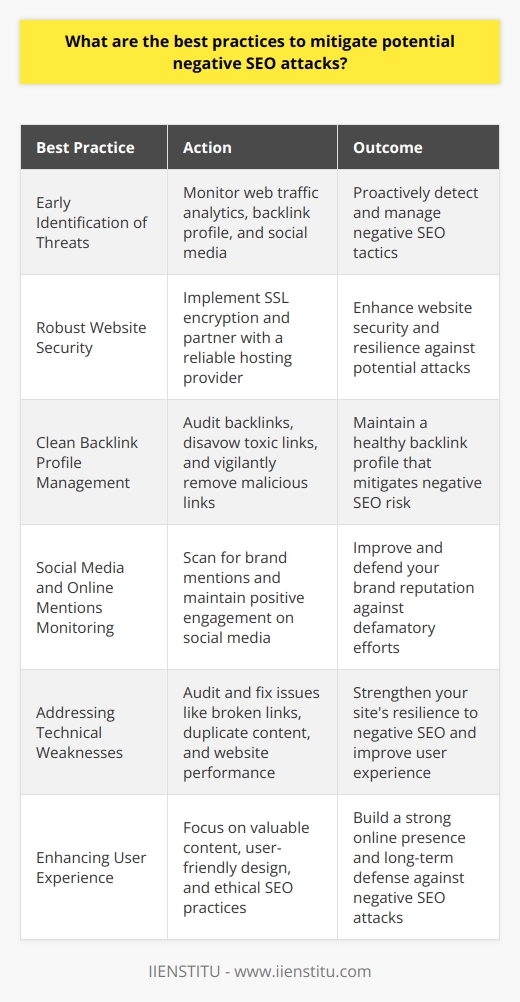
Are there any tools or resources available for monitoring and addressing negative SEO issues?
Subheadings:
Identifying Negative SEO
SEO Monitoring Tools
Addressing Negative SEO Issues
Identifying Negative SEO
Negative SEO refers to unethical tactics aimed at sabotaging a website's search engine rankings. These include spammy backlinks, content duplication, and fake reviews. As such, identifying these activities is crucial to protecting a website's search engine performance.
SEO Monitoring Tools
Several tools are available for monitoring a website's SEO health. For example, Google Search Console assists in tracking backlinks and inspecting indexing issues. Additionally, Ahrefs and SEMrush help in identifying unhealthy backlinks, as well as conducting regular site audits for detecting anomalies or sudden drops in search engine rankings. These tools provide valuable insights into potential negative SEO attacks.
Addressing Negative SEO Issues
Once a website owner has identified negative SEO activities, it is critical to address them promptly. For instance, if spammy backlinks are detected, one can use the Ahrefs or SEMrush tools to export a list of suspicious links and submit a disavow request to Google. This informs Google that certain backlinks should not be considered for a website's ranking. In cases where duplicate content is an issue, website owners can use canonical tags or contact the offending website and request the removal of duplicated content.
In conclusion, there are various tools available to help monitor and address negative SEO issues effectively. Utilizing these resources can safeguard a website's search engine performance and ensure its long-term success.
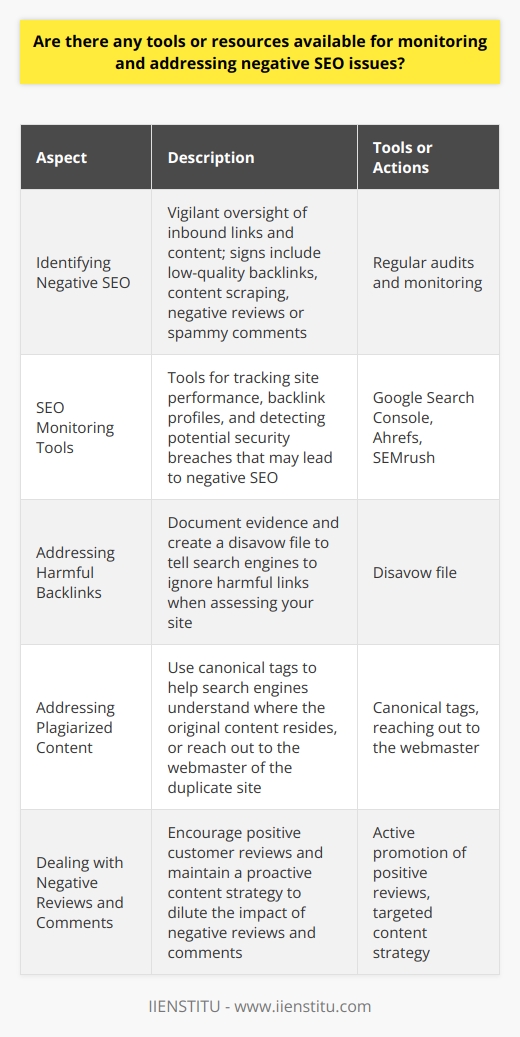
What are negative SEO strategies?
Defining Negative SEO Strategies
Negative SEO strategies refer to unethical practices aimed at sabotaging a competitor's search engine rankings. These disingenuous techniques often violate search engine guidelines and can result in penalties or even removal from the search index. The following sections detail various methods used in negative SEO campaigns.
Link Manipulation Techniques
One common negative SEO tactic is link manipulation or creating unnatural, low-quality backlinks pointing to a competitor's website. These could involve acquiring links from spammy, unrelated websites or large numbers of low-quality directory submissions. As search engines consider backlinks in determining site rankings, poor-quality links could degrade a site's reputation and ultimately harm its standing on search engine results pages (SERPs).
Content Duplication and Copyright Infringement
Another prevalent negative SEO strategy involves copying or scraping a site's original content and distributing it across multiple platforms without authorization. Content duplication can confuse search engines as they struggle to identify the original source, potentially diminishing the value of the copied piece and lowering the affected site's ranking. Additionally, copyrighted material duplication could result in legal disputes, which could further tarnish the targeted website's reputation.
Malicious Hacking and Site Security Exploits
Some malicious actors might resort to hacking a competitor's website, injecting harmful content or disrupting its normal functioning. By contaminating the site with malicious code or overwhelming it with traffic, these negative SEO attackers can make the victim's website inaccessible to users, plummeting its SERP rankings. Additionally, search engines may deprecate the compromised site as it now poses a potential threat to users' security and privacy.
Negative Reviews and False Reputation Attacks
A subtler approach to negative SEO involves spreading false information or negative reviews about a target's business, products, or services. This approach aims to tarnish the intended victim's reputation by undermining customer trust and potentially discouraging users from further engaging with the website. In turn, search engines can detect these negative signals, decreasing the affected site's search rankings.
Conclusion
In essence, negative SEO strategies encompass various malicious tactics intended to undermine a competitor's search rankings, ranging from link manipulation and content duplication to hacking attempts and false reputation attacks. Due to the potential damage these practices can inflict, it is vital for website owners to remain vigilant and implement preventative measures to safeguard against the malicious effects of negative SEO techniques.
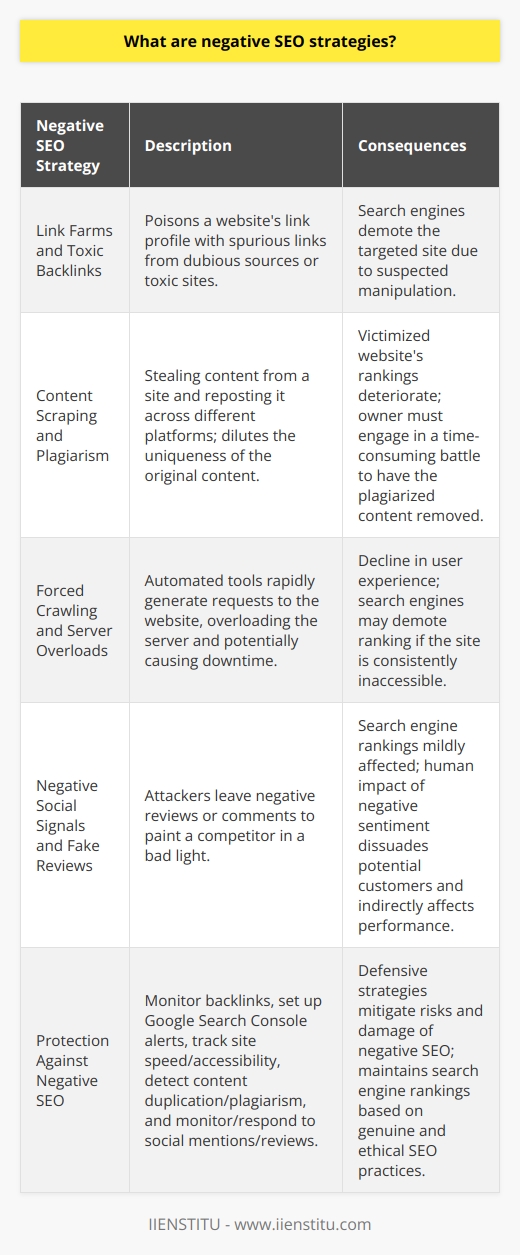
What is an example of negative SEO?
Negative SEO Example
Understanding Negative SEO
Negative SEO refers to unethical practices employed by some individuals to sabotage the search engine rankings of their competitors' websites. By employing various unsavory techniques, these individuals aim to negatively impact the rankings or visibility of their rivals, thus paving the way for their own site's improved standing.
Spammy Backlinks
One common example of negative SEO involves the creation of spammy or low-quality backlinks. In this scenario, an individual would intentionally direct a large number of low-quality or untrustworthy links towards their competitor's website. These poor-quality links may come from unrelated or controversial websites in order to detract from the reputation of the targeted site.
The Google Algorithm Impact
The motivation behind this tactic stems from Google's algorithm, which takes the quality and relevance of a site's backlink profile into account when determining search engine rankings. In a positive context, high-quality, relevant backlinks are beneficial for a website, demonstrating to Google that the content is valuable and trusted by other sites. However, when it comes to negative SEO, a sudden influx of low-quality or spammy backlinks can trigger Google's algorithm to downgrade the site's ranking, as it may appear untrustworthy or less authoritative.
Google’s Disavow Tool
To address the issue of negative SEO through spammy backlinks, Google introduced the Disavow Tool. This tool enables website owners to inform Google that certain backlinks should not be considered when assessing their site's ranking. By disavowing these low-quality links, the targeted website can disassociate itself from the negative impact of the links and potentially restore its search engine rankings.
Defending Against Negative SEO
It is crucial for website owners to monitor their backlink profile and stay vigilant against potential negative SEO attacks. Employing a proactive approach to managing one's backlinks and using Google's Disavow Tool when necessary can help mitigate the damaging effects of negative SEO tactics. Additionally, webmasters should maintain strong website security to prevent unauthorized access and regularly update their website's software to minimize potential vulnerabilities.
Conclusion
Negative SEO, though unethical, is a reality for many website owners. Recognizing the potential signs of a negative SEO attack and taking proactive measures to defend against such tactics is crucial to ensuring the continued success and visibility of a website in the highly competitive online landscape.
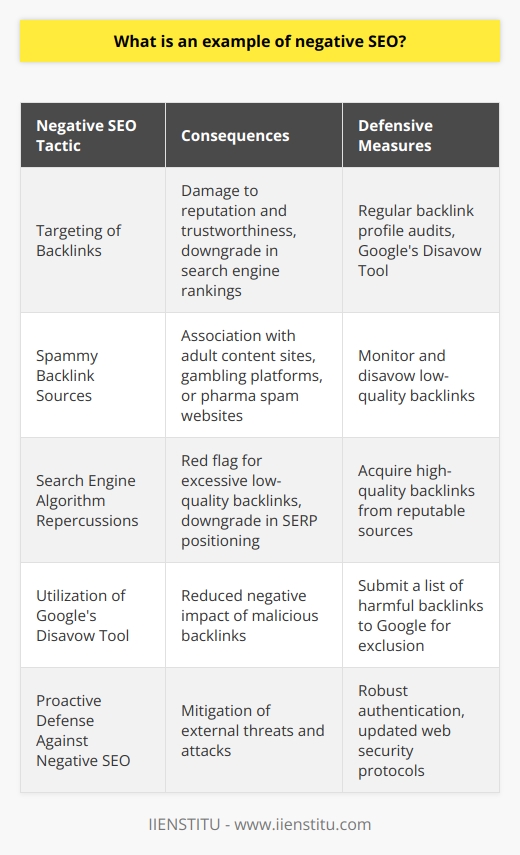
Does negative SEO still work?
Negative SEO Efficiency
Although negative SEO exists, its effectiveness in harming websites has lessened due to the search engine algorithms' advancements. While it initially had a significant impact on website rankings, Google's continuous efforts have largely mitigated the detrimental effects of negative SEO.
Evolution of Google Algorithms
Firstly, Google has made numerous algorithm updates, such as Google Penguin, which penalizes websites engaging in manipulative or unnatural link building practices, thereby reducing the exploitation potential. Nowadays, webmasters and search engine optimizers are often cautious about black hat techniques that could lead to website penalties.
Google's Disavow Tool
Secondly, the creation of Google's Disavow Tool has allowed webmasters to take control of the links directing to their website. By essentially 'disowning' bad or spammy links, webmasters can reduce the harm caused by negative SEO attempts.
Improved Detection Technology
Lastly, Google's continuous improvement in spam detection has led to its algorithms being more adept at recognizing and disregarding poor-quality links. Consequently, websites are less likely to be adversely impacted by negative SEO efforts from competitors.
Prevention and Monitoring Measures
While negative SEO may not be as potent as it once was, webmasters must remain vigilant about monitoring their website's backlink profile and staying up-to-date with Google's guidelines to maintain their site's integrity. This includes continuously monitoring for suspicious or spammy links and promptly disavowing any harmful ones.
Conclusion
In conclusion, while negative SEO still exists, its impact has significantly diminished due to advancements in search engine algorithms. While it may continue to cause minor disruptions, well-prepared webmasters can mitigate its effects and maintain their website's high-quality and well-ranked position.
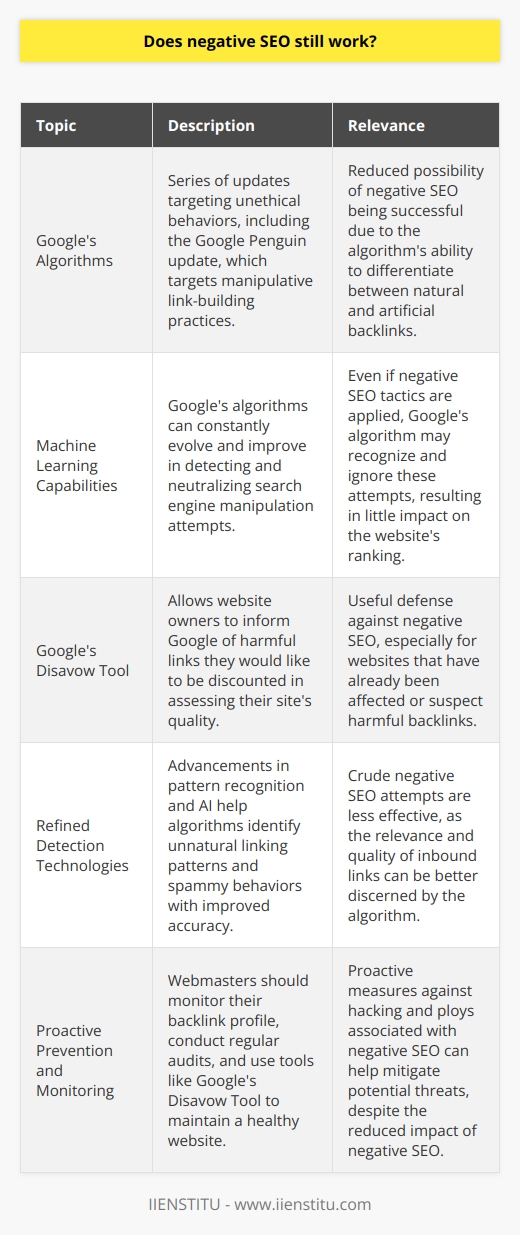
What are the most common methods utilized in negative SEO attacks?
Methods in Negative SEO Attacks
Actors in negative SEO attacks often employ a range of methods. One common method is link farming, where illegitimate links get flooded towards a website, affecting the reputation of the website, thereby lowering its ranking on search engine result pages.
Use of Duplicate Content
Another prevalent method is the use of duplicate content. Attackers often copy the original content from a website and distribute it over several platforms, which leads search engines to tag the original content as duplicated, thus reducing its credibility.
Fake Reviews
Fake reviews also constitute a common negative SEO attack method. Businesses sometimes become victims of false negative reviews created by attackers, which could substantially impact their reputation and customer trust.
Hacking Websites
Hacking a website forms another commonly occurring method. Attackers exploit security vulnerabilities, make changes to the website, and cause it to crash or become unresponsive- the ranking of the compromised website in search engine results takes a significant hit due to this.
Forceful Crawling
Lastly, forceful crawling is an alternate method used by attackers in negative SEO. They inundate websites with requests leading to slow loading times and potentially rendering the website unavailable, severely impacting its search engine ranking.
In conclusion, negative SEO attacks represent a malicious act where the perpetrators employ various methods such as link farming, creation of duplicate content, fake reviews, hacking, and heavy crawling to downgrade a website's SEO ranking. These methods pose significant threats to businesses and require adequate attention and countermeasures.
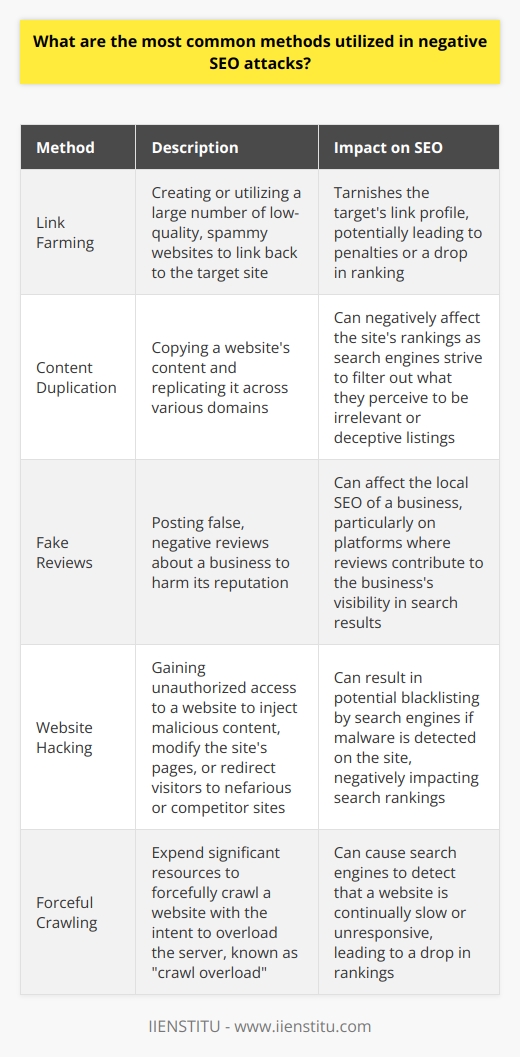
How can I minimize the negative impact on SEO due to factors beyond my control?
Understanding Uncontrollable Factors
Though you may not have control over all factors that can affect SEO, understanding them can mitigate their negative impacts.
Algorithm Changes
Google frequently updates its search algorithm. Stay informed about the latest changes and adapt your SEO strategy accordingly. Experts like Moz and Search Engine Journal often provide updates on algorithm changes.
Competitor Actions
Be vigilant about the activities of your competitors. Regular competitor analysis will help you understand their SEO strategies and make necessary adjustments to your plan.
Behavioural Changes
User behavior can sporadically change, affecting your SEO. Monitor changes in user behavior and modify your blog's content and design to align with these changes.
Limited Control
Although you have limited control over external SEO factors, you can influence them indirectly. Building and optimizing a user-friendly, well-structured website with high-quality content can help in reducing their impact.
Collaborations and Backlinks
Establish collaborations with high authority websites. High-quality backlinks from these sites can boost your blog's search engine ranking, effectively counteracting negative impacts.
Optimization of Existing Content
Constantly optimize your existing content for SEO. Regular updates and improvements can ensure your blog's relevance, thereby reducing the negative impact of uncontrollable factors.
Technical SEO
Ensure that your blog has a strong technical SEO foundation. Fast-loading pages, easy navigation, and mobile optimization can make your blog more attractive to search engines.
Conclusion
While it is impossible to control all factors impacting SEO, understanding these factors, vigilantly monitoring changes, and adapting your strategies can effectively reduce negative impacts on your blog's search engine ranking. Even though it involves constant effort and adaptation, the payoff in maintaining a high search engine ranking and a seamless user experience is well worth it.
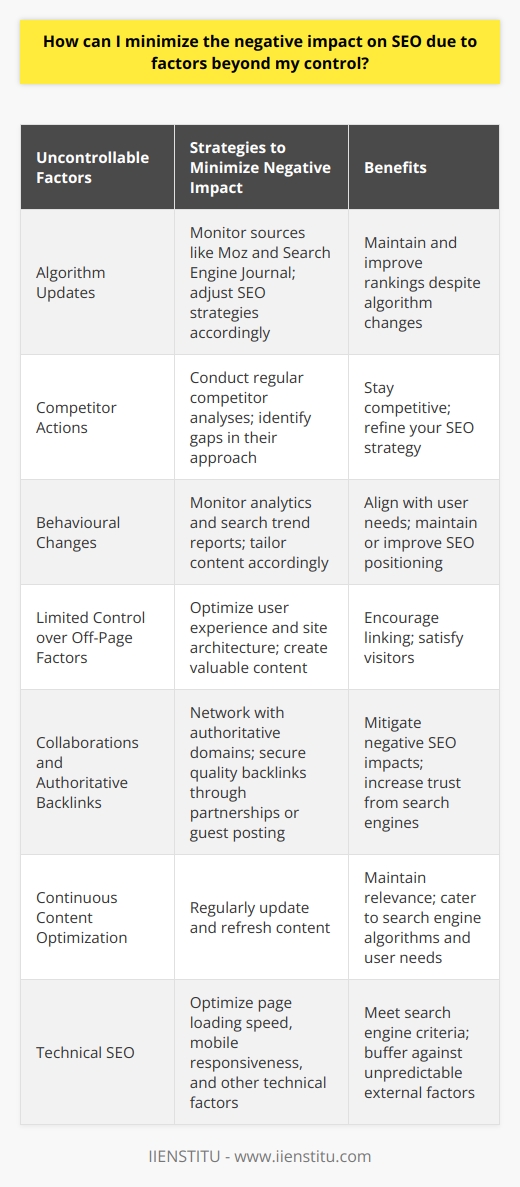
Are certain industries or websites more susceptible to negative SEO attacks, and if so, why?
Industry Susceptibility to Negative SEO Attacks
Certain industries and websites indeed have higher susceptibility to negative SEO attacks. This variability arises because of several key factors. Firstly, the industry competition level plays a critical role. In highly competitive environments like eCommerce, gaming, or the pharmaceutical industry, rival companies may resort to negative SEO to outrank each other.
Content Quality and Negative SEO
Poor quality or duplicate content makes websites more prone to negative SEO. Sites that heavily rely on content, like those in the publishing or blogging industry, often face such attacks. Google penalizes duplicate content, making these websites a target.
Site's Age and Negative SEO
The age of the website matters as well. Newer sites often lack a robust backlink profile, making them easy targets. Fraudulent negative SEO assaults can cause these sites to lose ranking fast.
Size of the Website
The size of the website also has an effect. Large websites have numerous pages prone to hacking or spam links. Therefore, more considerable online platforms need to put in extra effort to safeguard their sites.
Conclusion
In conclusion, high competition industries, websites dependent on content, newly launched websites, and large-sized platforms are more susceptible to negative SEO attacks. Enhanced security measures and quality content can thwart these potential threats to prevent ranking loss.
